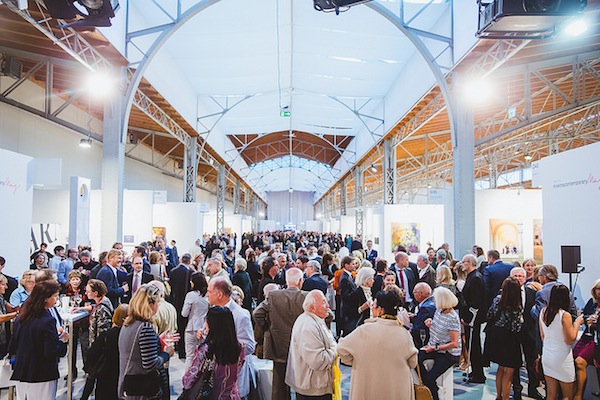
In its second year, viennacontemporary is already blazing a fiery trail. The fair, which rebranded last year stemming from the long-established Vienna Fair, years of connections act as a jumping-off point for the young event. With a focus on an international reach and the Eastern European market, the booths were top quality, and already by Friday, sales were rolling in accordingly.
At the press conference, Board Chairman Dmitry Aksenov boasted that the fair finally persuaded a number of international collectors, who they’d been inviting for years, to attend. And judging by the number of gallerists busy sealing deals at their booths, the newcomers were ready to buy. Director Christina Steinbrecher-Pfandt tells artnet News she thinks the increased international attention comes from two reasons: the core viennacontemporary team has been working together for five years, and that the quality of the art is consistently top-notch.
“The experience is just very good, and the art and presentation is excellent. You can see something here that you can’t see anywhere else, so people get curious,” she says.
Established Vienna dealers, as would be expected, reported a positive first day.
“I think the fair this year is much better than last year,” Galerie Krinzinger’s Dr. Ursula Krinzinger told artnet News. “There were a great number of people who came yesterday—the collectors, the curators, the museum directors—who were national and international specialists. If it goes on like this, it could be a really successful fair for us.”
Galerie Krinzinger’s booth. Photo courtesy viennacontemporary/A. Murashkin.
She emphasized the increased international interest, and contrasted the success of viennacontemporary to a struggling neighbor, Berlin’s abc Art Berlin Contemporary, implying that perhaps Vienna takes the sole reigns as Eastern Europe’s art market hub.
Her gallery had offerings from over 40 artists including Marina Abramovic, Chris Burden, Meret Oppenheim, and Daniel Spoerri, and a standout work by Bernd Oppl, Dark Matter (2016). The sculptural video installation is made of tiny rooms, which the artist filled with Ferrofluid. He recorded the black metallic substance expanding and moving, activated by magnets, to simulate a The Shining-esque incursion of a liquid with a mind of its own into an actual-sized room. The works ranged in price from €2,000 to €50,000, and Krinzinger reported an unexpectedly successful Thursday for sales.
Nedko Solakov, The Abstract Painting (with no frame), (2016). Photo courtesy of Georg Kargl Fine Arts, Vienna.
Georg Kargl of Georg Kargl Fine Arts was reluctant to talk sales, telling artnet News that the price of an individual work “doesn’t mean anything.” Nonetheless, he reported some sales had taken place, and was happy the fair began in a good way. The works in his booth came from a selection of 15 of the gallery’s artists, and Kargl spoke highly of Bernhard Leitner’s Ton-Sprung, Tafel, a collage of video stills depicting small cylindrical objects on top of speakers, bouncing from the sound vibrations. Kargl called it a “refreshing work” for an artist approaching 80 years old. He declined to say what exactly sold, but the works ranged in price from €12,000 to “something like €65,000.”
Young galleries reported similar success’ after day one. The winner of the Austrian Gallery Prize for best booth design by the Vienna Chamber of Commerce and Industry, Galerie Lisa Kandlhofer reported an unconventional sale: the walls of the booth. Artist Frauke Dannert painted the walls with colorful, abstract geometric motifs inspired by architecture, and she will install a version of the work in a private collector’s home. The gallery also sold a series of six small black and white multiple exposure photographs for €8,400.
Galerie Lisa Kandlehofer, winner of the WKO Gallery Austrian Prize. Photo courtesy viennacontemporary/A. Murashkin.
Newcomers didn’t miss out on the action, either. Taipei’s Liang Gallery is showing in Vienna for the first time, and hoping to establish a network in the Austrian and Eastern European market. They brought eye-popping moving image pieces and works on paper by Taiwanese artist Chen I-Chun. On Friday, they reported the sale of their most expensive work, a series of 12 drawings inspired by Japanese manga and incorporating found Google images of an explosion which the artist was a victim of, for €11,000.
Galerie Thomas Fischer, part of the solo expanded section with works dedicated to a single or to two artists, brought three photographic series: of former East Berlin, the Austrian border to former Soviet states, and everyday black and white snapshots of Vienna, by Japanese photographer Seiichi Furuya, who is based in Graz. The gallery’s first year at viennacontemporary, they wanted to bring work that had a connection to Austria, and the tactic was successful. Fischer reported a good opening night, with many collectors already familiar with Furaya’s work, and some sales. The photographs ranged in price from €2,500 for an open edition, and €3,800 for editions of five.
Also in the solo expanded section was Galerie Hubert Winter, who brought works by Judith Fegerl and Helga Philipp. The gallery reported a strong opening day, with sales to Austrian collectors, and one from Venezuela. Works by Fegerl and Phillipp both sold, for prices ranging from €2,800 for works on paper, to up to €25,000 for paintings and sculptures.
Galerie Hubert Winter’s booth. Photo courtesy viennacontemporary/A. Murashkin.
Not every gallery had such success by Friday afternoon, but every dealer artnet spoke to indicated at least some interest. Galerie Nathalie Halgand, representing Simon Mullan, had reserved one work that wasn’t on view at the fair. Mullan’s pieces, tile works ranging from small wall hangings, to room-divider-like sculptures, and a custom installation, were priced from €3,100 to €11,000.
In some ways, the fair is just finding its footing, but it’s already proving to be a strong marketplace.